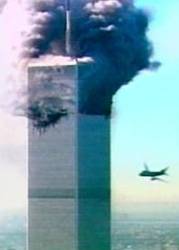
Quotes:
""People said it was like a Steven Spielberg movie," observes Ron Mann, a leading Canadian documentary filmmaker. "But nobody got up at the end of it.''
Words failed, though not the pictures. They told the story with operatic vibrato. Voices were superfluous."
"Pictures connect to our emotional side in a way that words don't," posits Lance Strate, chair of communications and media studies at Fordham University and eminent Marshall McLuhan scholar. "They're intimate and visceral. It's impossible to look at those pictures and not identify with (the victims). We see them and they are us."
Those feelings, if dimmed — because life moves inexorably onwards — are stirred anew, whenever the potent images cross our radar. (DiManno)
"There's a trauma associated with 9/11 that shouldn't be compared with anything else," Strate stresses.
"From the beginning, iconography replaced words. But it's clear, from the way those moving images are still voluntarily restricted, that American society has yet to make peace with the dreadful fact of 9/11, including its gut-wrenching pictography."
"The jumpers.
Upwards of 200 men and women, it's estimated, either leapt, fell or were blown out of the towers. But those ghastly images remain widely unacceptable, multiple-X-rated. Even the Naudet brothers refrained from shooting the jumpers, although the thud of human bodies hitting the ground can be heard in the background.
Readers responded with fury after some papers published one particularly seminal image, shot by AP photographer Richard Drew, of a man falling almost gracefully from the sky, an arabesque, as if in calm resignation to his fate, silhouetted against the vertical grid of the tower's pinstripe windows.
Tom Junod is the Esquire writer whose essay on the jumpers became a documentary, 911: The Falling Man, making its North American premiere this evening on The Passionate Eye (10 p.m., CBC Newsworld). Interestingly, it will not be shown on American television at this time, though the Discovery Channel has picked it up for broadcast next February.
Junod's research strongly suggests the identity of that one falling man in Drew's picture, which has never been conclusively established. He was possibly Jonathan Briley, a 43-year-old sound engineer who worked in the audio-visual department at Windows on the World restaurant.
But the one represents the many who made an unimaginable choice that day — the Unknown Soldier metaphor. And they've been all but airbrushed from the hagiography of 9/11, as if they were an obscenity.
"The jumpers were uniquely upsetting for the public,"...."Five years on, though, America is not yet ready to embrace the horror of the jumpers. There is no room in the iconography of 9/11, the deconstruction of that monumental violation, the wound, for such blunt desperation, such resignation."
Source: DiManno: Images tell tale when words fail Toronto Star Sep. 6, 2006 (page 1) ROSIE DIMANNO